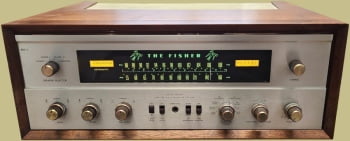
The Fisher 801 receiver was introduced in 1972 and is a four channel receiver. It retailed for $749.95 which was a fairly large sum of money at the time. It was the top-of-the-line quad receiver in Fisher’s lineup which included the 601, 701, and the 801. The 801 is an improved version of the earlier 701 which came out in 1971. In 1973 Fisher introduced the X04 series which included the 304, 404 and 504, but the 801 was still on the market at that time so there were advertisements with both the 801 and x04 series receivers in them.

The Fisher 801’s FM receiver has a few notable features. One is the inclusion of a stereo beacon, which aids in the tuning process and serves as a signal strength meter for both AM and FM frequencies. The beacon also functions as a frequency indicator for the ‘autoscan’ feature (more on that later), simplifying the station-seeking process
Front Panel
The front panel of the Fisher 801 receiver is laid out nicely given the amount of functionality required for a 4-channel receiver. It hosts a variety of controls, enabling users to tailor their audio settings. These controls include manual tuning, tape monitoring, input selection, mode selection, concentric front/rear (F/R) bass adjustments, concentric F/R treble adjustments, concentric F/R balance control, and a speaker selector.
For manual tuning, the receiver offers a standard dial and tuning knob. However, for convenience, an autoscan function is also available, automatically searching for available stations within the specified range.
For volume control, separate slider-type volume controls are available for the front and rear amplifiers, allowing users to fine-tune the sound output.

The 801 receiver incorporates push switches for additional functionalities, including front and rear high filter settings, front and rear loudness compensation, FM muting, AFC (Automatic Frequency Control), and the choice between autoscan or manual tuning options. These features provide users with a comprehensive array of audio controls and optimizations to create a highly personalized listening experience.
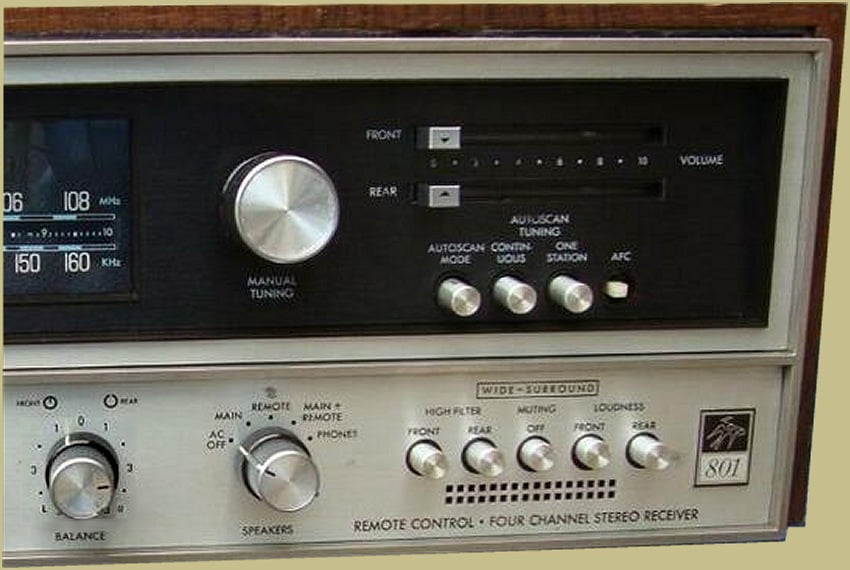
Remote Control
The Fisher 801 is supplied with an ultrasonic WT-50 wireless remote control. The controller itself is a small hand sized ultrasonic transducer powered by a standard transistor type 9-volt battery. Press a button on top of the controller and the automatic tuning system (autoscan) is activated. The ultra-sound receiver built into the Fisher 801, is concealed behind a decorative grill at the lower right corner of the front panel.
For $14.95 an optional RK-40 wired remote control with 20 feet of cable was also available that connects to a socket on the receiver rear panel.
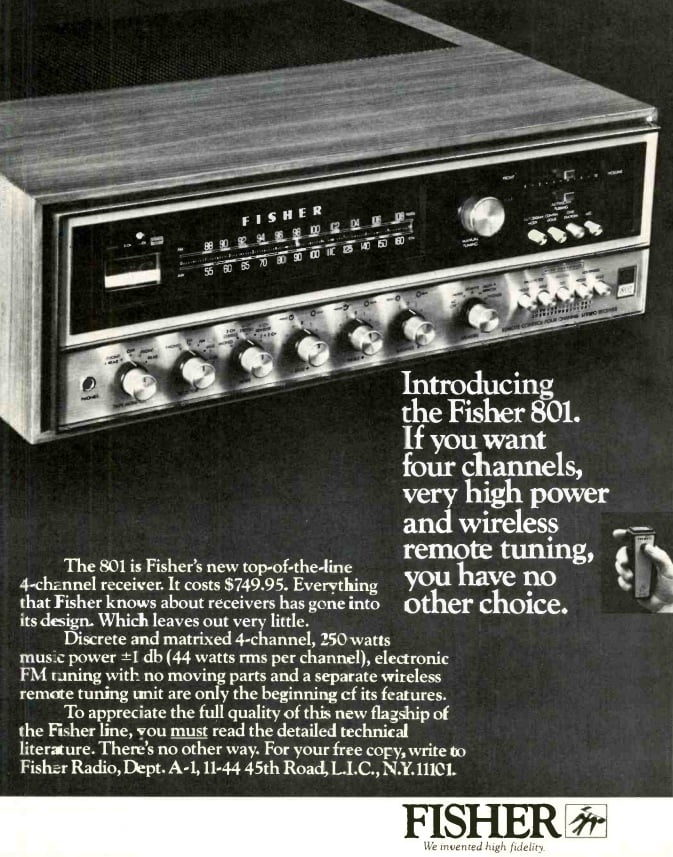
FM Tuner
The FM tuner uses electronic tuning. A potentiometer connected to the dial drive adjusts voltage to the capacitor diodes which, in turn, tune the front end. An autoscan circuit can be used to automatically sweep from the bottom of the band. With the autoscan set to continuous the tuning will sweep until you release the control. With the autoscan set to One station the tuning will lock on the next higher frequency station and remain there. When manually tuned, the signal strength meter and the AFC insure center channel tuning.
One review magazine said of the Fisher 801 FM tuner:
The FM funer’s sensitivity measured 1.8 uV, with 55 dB of quieting occurring at only 7 uV. This is great performance. It takes but 10 uV to trip the FM mute or lock the autoscan (autoscan will pass over stations weaker than 10 uV). At standard test level of 1000 uV, the distortion measured 0.27 percent with a 75 dB signal to noise ratio which is dead quiet from any viewpoint. The frequency response was a tight +0.5/-0.2 dB from 20 to 15,000 Hz. The selectivity was notably excellent and we were even able to separate adjacent channel stations. And if all this isn’t enough, the worst-case stereo separation was 46 dB at 1000 Hz and 38 dB at 15,000 Hz – many tuners can’t deliver 38 dB separation at 1000 Hz! Simply fantastic! But measurements alone cannot really express the excellence of the FM reception. It is clean, amazingly clean. Many in our listening panel feel the 801’s FM performance is perfection.
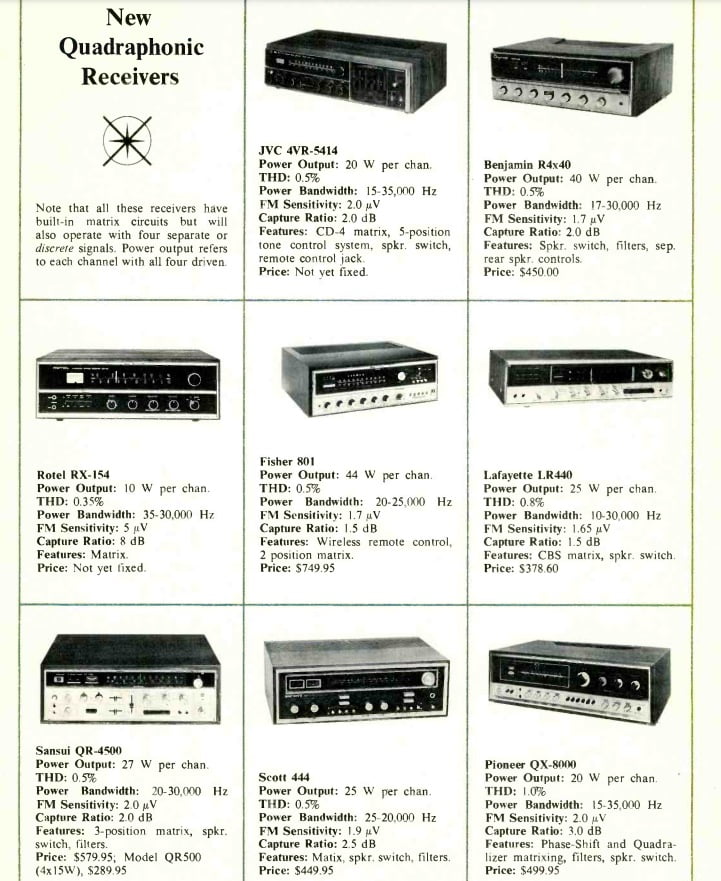
Autoscan
Here is another magazines explanation of Fisher’s autoscan feature:
Fisher’s Autoscan, which has appeared on a number of previous models, is just what the name implies. Once the Autoscan button is pressed. the continuous-scan button acts like a sort of fast-forward control for moving across the FM dial, the action stopping at the next station after the control is released; the one-station button will advance the tuner only to the next station on the dial. The button on the wireless remote control duplicates the continuous-scan function but can be used for single-station advance by pressing the button only momentarily. The remote unit is powered by a 9-volt cell and contains a supersonic (22.8 kHz) transducer that is aimed at a small grill in the receiver’s front panel for use.
2 + 2
The “2 + 2” function on the Mode switch is a quadraphonic matrix-decode circuit similar to that in the original E-V decoder; the only difference between the pop and classical settings is that the output to the back channels is reduced in the latter position to suggest hall (or ambience) sound rather than that of being surrounded by the musicians. While the front panel markings suggest use in simulating quadraphonics from stereo program material, 2 + 2 can be used to approximate decoded playback of matrixed recordings as well.
AM Tuner
The AM tuner is straightforward. It is tuned by a standard tuning capacitor which is attached to the dial drive cord. Actually, the AM capacitor and the FM tuning potentiometer are connected together.
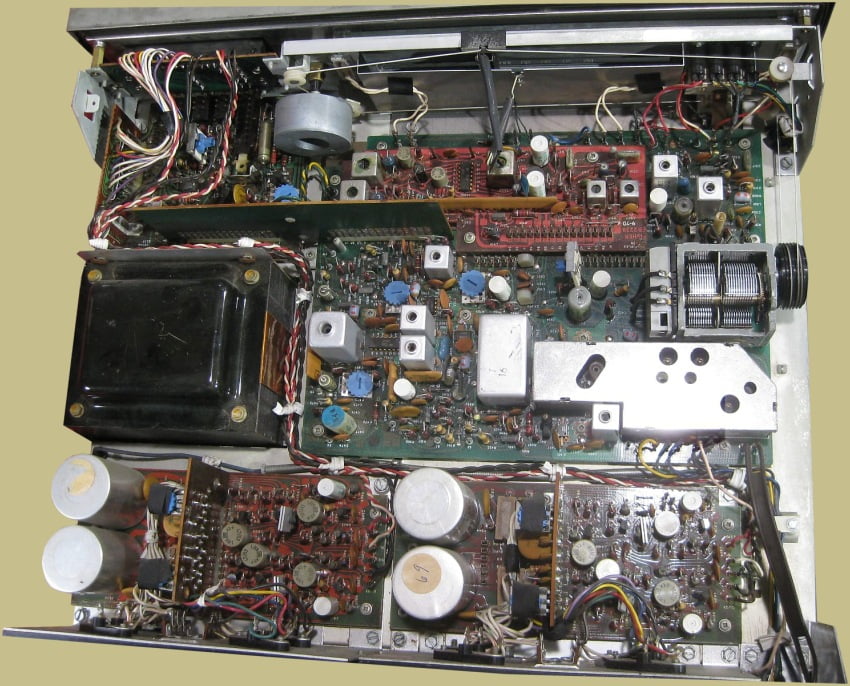
Amplifier
The receiver features two separate stereo amplifiers for the front and back channels, providing a total of four channels. These amplifiers are independent, each equipped with its own set of controls and inputs. While the front and back amplifiers are nearly identical, the front amplifiers have a unique magnetic phono input. The other inputs, such as aux 1, aux 2, and tape, are available for both sets of amplifiers.
Each of the four amplifiers includes outputs for main and remote speakers, tapes, and phones. The front and rear stereo amplifier signals are mixed together at the front panel jack, enabling users to monitor the audio using standard stereo headphones.
There is a derived ambient sound decoder connected to the front stereo amplifiers, When switched in, the decoder automatically connects the derived ambient sound from any signal source to the rear stereo amplifiers.

The paired stereo amplifiers (front and back) are rated for 44 watts rms per channel into 4 ohms at 0.5 percent distortion. Both stereo amplifiers, except for the phono input found only on the front stereo amplifiers, are identical and can be individually used; for example, the phono can feed main speakers in the living room while the rear channels feed a tape to remote speakers on the patio. The derived ambient sound decoder is automatically connected to the rear stereo amplifiers when the front panel mode switch is set to “2 + 2”.
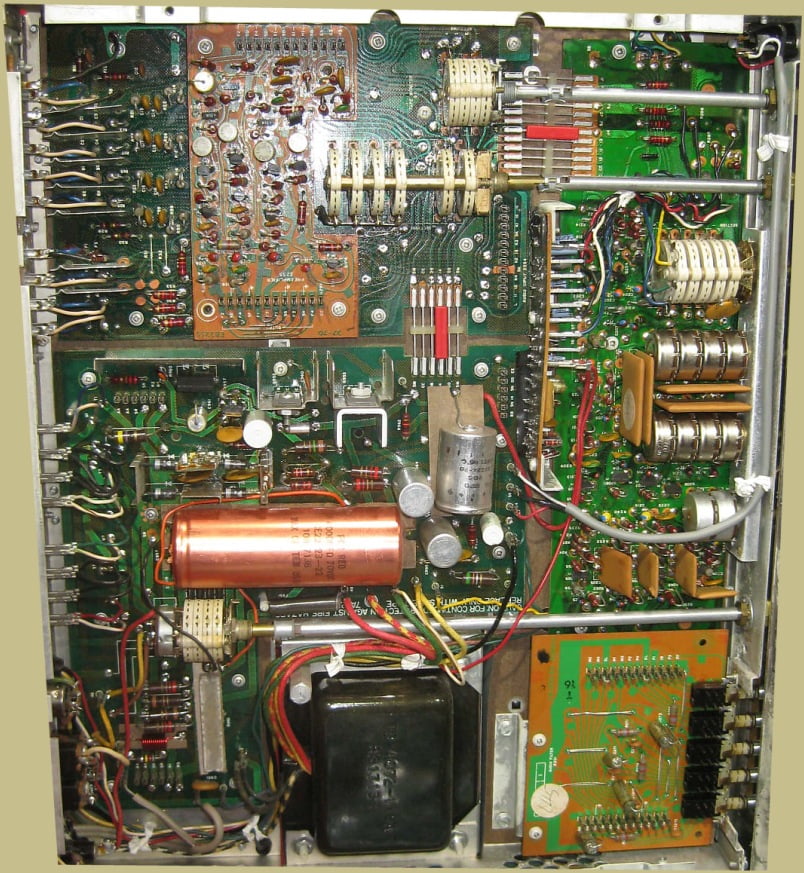
One standout feature of the amplifier section is its exceptional performance in dealing with magnetic input hum and noise. Measuring at 62 dB, the amplifier achieves notably hum-free operation, comparable to being powered by a battery. This low level of noise interference ensures a clean and undisturbed audio output.
Overall, the Fisher 801’s amplifier section stands out for its robust power delivery, accurate frequency response, low distortion, and remarkable noise-free operation.
Back Panel
The back panel has screw terminals for FM (300 ohm) and AM antennas. There are spring clips for eight speakers (main and remote quadraphonic sets). There are also connections for phono (stereo), quadraphonic sets for aux 1, aux 2, and tape monitor inputs plus the tape recording output. There also is a jack for use with an optional remote control FM tuning unit (an alternative to the WT-50 wireless Autoscan control delivered with the 801) and a ground connection. Two switched AC outlets are included as well.

The Fisher 801 is a good receiver. It has a great FM tuner and the build quality is above average. For those looking for a vintage quadraphonic experience or who are into mid century aesthetics then the 801 might be for you. However, they are fairly rare and only come up for sale occasionally.

